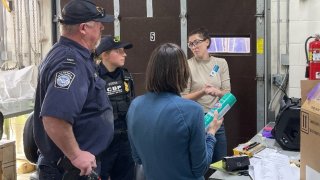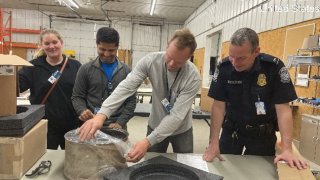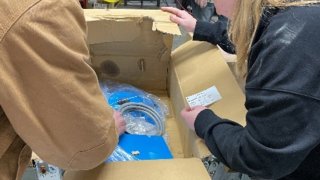Enforcement and Compliance Annual Results for FY 2023: Environmental Justice
In FY 2023, EPA’s enforcement and compliance assurance programs continued to vigorously address compliance with and violations of environmental statutes specifically in communities overburdened by pollution, and to center environmental justice (EJ) considerations throughout the entire enforcement process.
The key elements of the EPA’s enforcement and compliance assurance programs’ EJ strategies and successes in FY 2023 are highlighted here.
Increasing Inspections in Overburdened and Vulnerable Communities
Increasing EPA’s presence in communities overburdened by pollution is a cornerstone of EPA’s enforcement and compliance assurance programs’ EJ strategy. Inspections to assess compliance requirements, including compliance with existing enforcement orders, are critical to uncovering violations of environmental laws, bringing appropriate enforcement actions, and deterring further unlawful conduct that may harm communities, especially those that are overburdened or more vulnerable to the effects of contamination. EPA’s enforcement and compliance programs committed to increasing the percentage of inspections in communities with potential EJ concern to 50% during FY 2023 from past levels of approximately 30%. EPA surpassed that goal this year, conducting 60% of all EPA on-site inspections at facilities located in overburdened communities, which should result in on the ground health benefits from resulting enforcement and compliance.
EPA’s enforcement and compliance programs also for the first time incorporated EJ considerations into all six of the Agency’s FY 2024-2027 National Enforcement and Compliance Initiatives (NECIs), which focus enforcement and compliance resources on the most serious environmental problems facing the United States. Folding environmental justice considerations into all we do is now a core element of all enforcement and compliance work, including the six NECIs. EPA will focus more NECI inspections and compliance monitoring activities in already overburdened or vulnerable communities, to ensure that the benefits of our nation’s environmental laws can be shared by everyone living in the United States.
Timely and Comprehensive Relief for Communities
EPA continues to actively focus on concluding cases that impact communities with potential EJ concerns so they may [reap] the on-ground health benefits of our cases. In FY 2023, 55% of completed civil cases addressed facilities in communities with potential EJ concerns. This is the highest percentage of finalized cases since EPA’s enforcement and compliance programs began tracking EJ statistics a decade ago and continues a steady increase since FY 2021.
As part of these cases, EPA is vigorously pursuing case resolutions that address harm to communities overburdened by pollution. In addition to resolving ongoing noncompliance, EPA is exercising the full breadth of our statutory authorities to pursue actions that prevent future violations and remediate past harm to communities caused by excess pollution. For example:
-
Order to Remove Dangerous Chemicals at Refinery Near Overburdened Community: EPA issued an administrative order on consent to Port Hamilton Refining and Transportation LLLP (PHRT), requiring it to hire experts to safely remove hazardous chemicals that were not being properly managed at the company’s oil refinery on St. Croix, U.S. Virgin Islands. EPA issued the order under the Clean Air Act after an inspection identified significant safety concerns, including corrosion of piping and valves, which could have resulted in a chemical release or fire.
Addressing Imminent and Substantial Endangerment Situations
To facilitate early action in situations that may pose immediate risks to overburdened communities, EPA continues to improve cross-program coordination and planning that promotes the use of all enforcement tools to address harm, including bringing imminent and substantial endangerment cases when appropriate. Use of these legal tools can provide rapid relief for communities. For example:
Clean Air Imminent and Substantial Endangerment Action
On February 28, 2023, EPA and the Department of Justice (DOJ) filed a complaint under the Clean Air Act alleging imminent and substantial endangerment to public health caused by Denka Performance Elastomer’s (“Denka”) carcinogenic air pollution at its neoprene manufacturing facility in LaPlace, Louisiana, located in a community with environmental justice concerns. This complaint seeks to compel Denka to significantly reduce hazardous chloroprene emissions from its facility, and greatly reduce the exposure of chloroprene levels to the community. This action is a fulfillment of EPA Administrator Regan’s pledge to the community during his Journey to Justice Tour, to take strong action on Denka’s harmful chloroprene pollution.
Safe Drinking Water Act Orders
In FY 2023, EPA issued 203 Safe Drinking Water Act (SDWA) orders to public water systems which collectively protected more than 1.9 million people. Eight SDWA § 1431 emergency orders were issued to protect almost 2,000 individuals in small, overburdened communities. Examples of SDWA enforcement activity include:
-
In November 2022, DOJ, on behalf of EPA, filed a SDWA complaint to address the emergency situation with the public water system in Jackson, Mississippi. The parties ultimately reached agreement on a proposed SDWA stipulated order which, among other things, included the appointment of an interim third-party manager to assist in the rehabilitation of the city of Jackson’s drinking water system.
-
EPA performed per- and polyfluoroalkyl substances (PFAS) sampling of private drinking water wells near military installations with known, significant PFAS contamination located in communities with potential EJ concerns.
Superfund Enforcement at Federal Facilities and Private
EPA resolved 12 Comprehensive Environmental Response, Compensation, and Liability Act (CERCLA, also known as Superfund) disputes at federal facilities listed on the National Priorities List that are in or near communities with potential environmental justice concerns.
In December 2022, EPA issued the Best Practices for Oversight and Enforcement of Community Involvement Requirements to Strengthen Environmental Justice at Federal Facility NPL Sites to provide EPA regional Superfund teams with best practices for oversight and enforcement of community involvement (CI) requirements at federal facility National Priority List (NPL) sites.
EPA’s FY 2023 Superfund enforcement work had a significant impact on communities with potential EJ concerns. Of the 84 Superfund sites with new enforcement agreements, 68% were adjacent to communities overburdened by pollution. The 137 enforcement agreements finalized in FY 2023 impact approximately 897,527 people living within a one-mile radius of a Superfund site, with 85% (759,373) of the people living in communities with potential EJ concerns. More information on cleanup enforcement accomplishments and the benefits to communities with potential EJ concerns is available in the Superfund enforcement section of this report.
EPA also integrates EJ considerations into every environmental criminal investigation and prosecution. Forty-three percent of the defendants sentenced in FY 2023 committed crimes that impacted communities overburdened by pollution. For criminal violations, EPA seeks punishments that serve as effective deterrents and that assure communities that illegal pollution is not recurring. For example, in a case involving violations of the Clean Water Act and other federal statutes, the owner of a drum recycling company located in an overburdened community in South Seattle, Washington, was sentenced to 18 months of incarceration, 36 months of supervised release, a fine of $250,000, and a special assessment of $3,500 for lying to regulators and investigators over dumping caustic chemicals into a sewer system. The company was sentenced to 60 months of probation and a special assessment of $14,000.
- Read more: Seattle Barrel cleaning company and its owner sentenced for ten-year water pollution scheme
Community Engagement
Early and frequent community engagement with overburdened and vulnerable communities is an essential element of any effort to address environmental injustices. Communicating with and understanding a community’s concerns, among other things, better informs EPA’s ability to negotiate appropriate relief and cleanup work that is responsive to those concerns.
Examples of community engagement activities in FY 2023 include:
-
EPA engaged with a work group convened by the National Environmental Justice Advisory Council (NEJAC) to develop a direction for work related to Federal Insecticide, Fungicide and Rodenticide Act (FIFRA) Worker Protection Standards (WPS) compliance monitoring. EPA requested that the NEJAC suggest how EPA can incorporate a deeper understanding of farmworker concerns about WPS inspections into training materials by (1) providing feedback, observations, or experiences about inspections to help EPA enhance training and thereby improve inspections and enforcement, and (2) recommending communication approaches, processes, or strategies to increase information sharing and build trust between WPS inspector and farmworkers.
-
Removal assessment for potential contamination from a former wood preserving facility. EPA achieved a settlement with Union Pacific Railroad Company (“Union Pacific”) that strengthens environmental and public health protections to the Greater Fifth Ward community in Houston, Texas. The Fifth Ward is a community with potential EJ concerns and of interest to several public entities. Under the agreement the company will conduct approximately $6.9 million in removal assessment work as well as pay future response costs. The removal assessment work includes on- and off-site soil sampling, vapor intrusion investigations, evaluations of the off-site storm sewer system for potential contamination, and development of a proposal supporting EPA’s community involvement plan.
-
FIFRA outreach efforts to overburdened communities: EPA launched a bilingual advertising and social media campaign that resulted in millions of views to a National Pesticide Information Center educational website and they partnered with the state to provide education and outreach publications on pest mitigation to all nine federally recognized tribes in Oregon. Additional activities included distributing compliance assistance materials on Worker Protection Standards to protect farmworkers from exposures to pesticides, in collaboration with the Coeur d’Alene Tribe Circuit Rider Program in Idaho, and the Yakama Nation in Washington; participating with the city of Seattle’s Parks and Recreation in three community outreach events; and distributing hundreds of bilingual materials to families on pesticide safety, pollinator protection, children’s health, air quality, lead safety, and energy conservation.
-
Red Hill Community Engagement: In response to comments on the proposed consent order with the U.S. Navy to oversee the defueling and closure of the Red Hill Fuel Facility, EPA crafted unique requirements for the establishment of a “Community Representation Initiative” (CRI). EPA facilitated the formation of the ten-member CRI that represented the Hawaiian community by hosting a public scoping meeting, conducting a survey, soliciting for nominees, and hosting a public election. The Navy was required to meet with the CRI community representatives twice a quarter to share information and receive input on critical decisions relating to defueling, closure, and drinking water at Red Hill and Joint Base Pearl Harbor-Hickam.
-
California Environmental Justice Enforcement Action Plan – The EPA and California EPA (CalEPA) finalized an Environmental Justice Enforcement Action Plan that focused on better addressing and communicating with communities on facility compliance. The Action Plan identified five communities across the state where there would be a sustained commitment. EPA and CalEPA have participated in and/or hosted dozens of public meetings and created activity logs summarizing regulatory roles at specific facilities of concern and developed a framework for a Rapid Enforcement Response Task Force to mobilize resources for urgent issues.
-
Community Tips Aid in Monitoring EPA’s Pennsylvania Region Metal Shredder Facilities – The EPA issued two administrative orders on consent to Metal Shredders in Allegheny County Pennsylvania (Metalico and TMS) for failure to have proper operating permits. Both facilities are located in communities with potential EJ concern and were the subject of heightened community concern and interest. EPA and Allegheny County Health Department worked together to use community tips and video feed from local community groups to assist in monitoring site conditions.
Increased Public Access to Information and Compliance Data
Greater public access to compliance data can enable communities to better understand and manage risks and monitor compliance at facilities and sites in their area. EPA’s enforcement and compliance programs’ Enforcement and Compliance History Online (ECHO) provides the public with compliance and enforcement information for approximately 800,000 EPA-regulated facilities nationwide. In FY 2023 more tools and EJ capabilities have been incorporated, advancing EPA’s goal to provide the public with improved access to enforcement data. Examples include:
-
Clean Air Tracking Tool (ECATT) provides an integrated view of Clean Air Act data and is the first EPA interface that combines data about emissions, enforcement and compliance, environmental justice, air monitoring stations, and modeled toxic risks. Communities now have access to a tool that can be used to evaluate emissions at stationary sources of air pollution and analyze general air quality in the United States in communities with potential EJ concerns or with high risks of health impacts.
-
PFAS Analytic Tools bring together national datasets into a searchable, map-themed webpage that allows users to filter, zoom in and download information such as drinking water testing results, PFAS chemical production, regulated facilities that may use PFAS, detection of PFAS at federal agencies, and toxic release/effluent discharges.
-
Benzene Fenceline Monitoring Dashboard provides self-reported benzene monitoring data from petroleum refineries. Benzene is a Clean Air Act hazardous air pollutant that must be monitored under the 2015 Petroleum Refinery Sector Rule. Benzene data are collected along the perimeter of the refinery.
EPA Work Exempt from EJ Identification
EPA has several enforcement programs where the location of the violation, or location of where EPA identified the violation (e.g., a company’s headquarters), is not sufficient for an EJ analysis (e.g. imports, mobile sources, pesticides distributed at big box stores). However, we know that these violations often impact communities overburdened by pollution:
United States–Mexico–Canada Agreement (USMCA) Import Border Compliance Project
With funding from the United States Mexico Canada Act (USMCA), EPA and other federal agencies led a series of Import Operations, providing onsite training nationally to Customs and Border Protection Officers on Federal Insecticide, Fungicide, and Rodenticide Act (FIFRA) and Clean Air Act (CAA) import requirements, resulting in real time denials of non-compliant products and pesticide sampling for product integrity. Other participants in the training included State and Tribal Inspectors, USDA & FDA Officers, and the Bureau of Consumer Protection.
In FY23 this included 14 Import Operations at ports of entry on the US Northern border. In addition to training, these operations also included the inspection of over 400 shipments; denied entry of 36 non-complaint vehicles; and issuance of 110 Notices of Refusal of Admission (NORA), preventing illegal pesticide products from entering the US. EPA has been approved for additional funding to continue this project in FY24 and will expand the scope to include ozone depleting chemicals, a priority under a National Enforcement and Compliance Initiative (NECI), and ports of entry on the southern US border.




